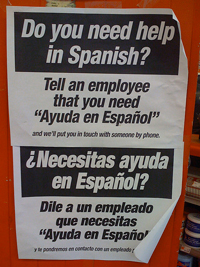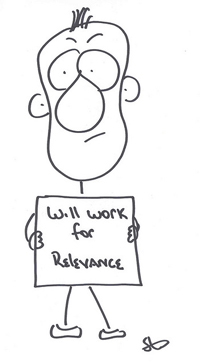
Source: “Do you need help in Spanish?”, Chris Devers, Flickr
In the graphic organizer in the previous section, you identified several items of evidence that were not clearly relevant to this thesis:
I am never going to be a fluent speaker of Spanish, even though I have tried and tried to become one.
One of the items that was not clearly relevant was this statement: “I have tried to watch an hour of television in Spanish every day.”
There is no obvious connection between watching Spanish television programs and becoming fluent in Spanish, but that doesn’t mean that there is not a connection at all. The author just has to make the connection clear.
Imagine that a reader of this essay comes to the statement, “I have tried to watch an hour of television in Spanish every day.” Which of the following answers will make this item clearly relevant? (If you’re not sure, click every box to read the feedback for each item.)

Source: Relevance, Steve Heath, Flickr
If you come across evidence in your essay that isn’t clearly relevant, consider whether or not the relevant information simply needs to be written more clearly before you discard it. This is often easy to do by adding a sentence or two.
The graphic organizer asks you to make relevant certain pieces of evidence in an essay called “How I Made Good Friends by Volunteering,” in which the author writes about working as a volunteer at a film festival.
A long anecdote about how the author got free popcorn at the festival, ate too much, and got sick would be irrelevant. Irrelevant evidence isn’t really evidence at all. You need to get rid of material in your essay that does not support your thesis.
It is possible that one of the other volunteers took care of the sick author. Maybe after this, the author felt a bond with the helpful volunteer, which led to them becoming good friends. Now the story about getting sick would be relevant.

Source: Popcorn, pauls95blazer, Flickr
Some material is clearly relevant. Some is clearly irrelevant. Some needs to be made relevant. During revision you need to evaluate your evidence as “clearly relevant,” “clearly irrelevant,” or “needs a connection.” After evaluation, add the connections for the pieces of evidence that need them.